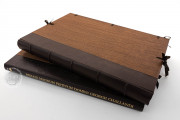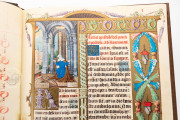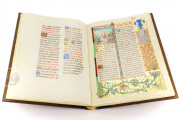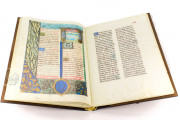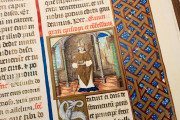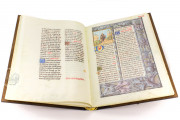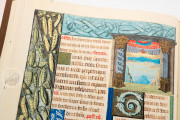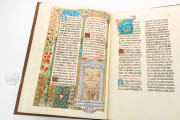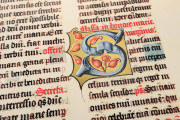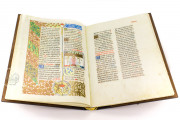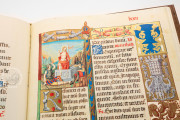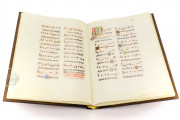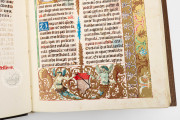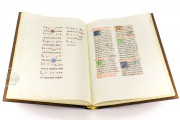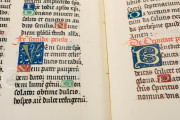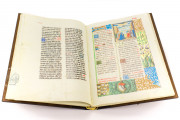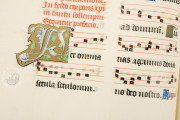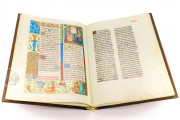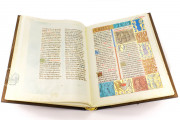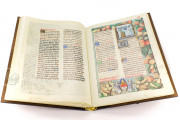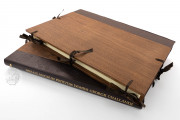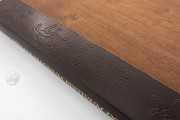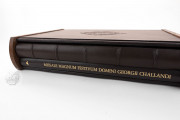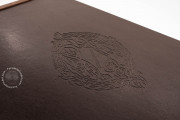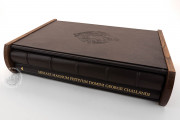The Missal of Georges de Challant was copied and illuminated in the late fifteenth century at the behest of its namesake for the collegiate church of Sant'Orso in Aosta, where it remains today. It is a large book containing the prayers, readings, and chants of the Catholic Mass arranged according to the Church calendar, beginning with the first Sunday in Advent, the season of fasting before Christmas. The manuscript's illumination, the work of a painter active in Switzerland and Ivrea before entering the employ of Georges de Challant, includes a full-page miniature of the Crucifixion and fourteen column miniatures.
The Challant family coat of arms (silver with a red bar across the top and a thin black stripe diagonally across the whole) appears in many of the manuscript's painted borders, as often as four times on a single page (fol. 9r).
Illustrating the Canon of the Mass
The first prayer at the consecration of the Eucharistic elements at Mass, Te igitur, was customarily illustrated by a scene of the Crucifixion, inspired by the opening letter T of the prayer. In the Missal of Georges de Challant, the dramatic scene is presented as a monumental full-page miniature with a view of the architecture of Jerusalem in the distance (fol. 74v).
Local Saints Pictured
Sant'Orso houses the relics of its namesake, Saint Ursus of Aosta, a sixth-century figure who preached against the Arian heresy. It is also the burial place of the fifth-century bishop Saint Gratus of Aosta. Both are accorded masses in Georges de Challant's manuscript, each introduced by a portrait of the saint (fols. 30r and 116r).
Miniatures in Camaïeu and Grisaille
Most of the miniatures are in full color, but some are in grisaille (shades of gray) or camaïeu (shades of a color other than gray, from the French for cameo). The most dramatic is the miniature of the Visitation, rendered entirely in tones of gray except for a golden shower representing the divine that descends on the embracing Virgin Mary and Saint Elizabeth (fol. 13v).
Peas and Peaches
Each page with a miniature or historiated initial features a painted border in the French style of the period. Many feature illusionistic plants arrayed before backgrounds divided into geometric segments of different colors. The chosen plants, including peas (fol. 125v) and peaches (fol. 117r), are strikingly original.
Other borders are filled with fantastic creatures, garlands, and candelabras, motifs known as "grotesques" because of their association with the underground "grottos" of the unexcavated ancient Golden House of Nero (e.g., fols. 75r and 83r).
Music for a Priest
The text was written by a single scribe in two columns in Gothic Textualis, sometimes called Missal Script because it was favored for stately liturgical volumes. The chants to be sung by the choir at Mass are not notated, but the text script is slightly smaller. The simple melodies of the prayers to be intoned by the celebrating priest are written in square notation on staves of four red lines.
Georges de Challant and the Church of Sant-Orso
Georges de Challant-Varey (d. 1509), the manuscript's patron, was the prior of Sant'Orso from 1468 to 1509. He patronized the church's rebuilding in the late fifteenth century, which incorporated the earlier crypt and traces of eleventh-century frescoes. The missal is a fitting adornment to the renewed building.
The couple pictured in the border of the page opening the feast of the Immaculate Conception of the Virgin probably represents Georges's parents (fol. 13v). Eight leaves with supplemental masses were incorporated into the manuscript in 1531.
We have 1 facsimile edition of the manuscript "Missal of Georges de Challant": Grande Messale Festivo di Giorgio di Challant facsimile edition, published by Priuli & Verlucca, editori, 1993
Request Info / Price

